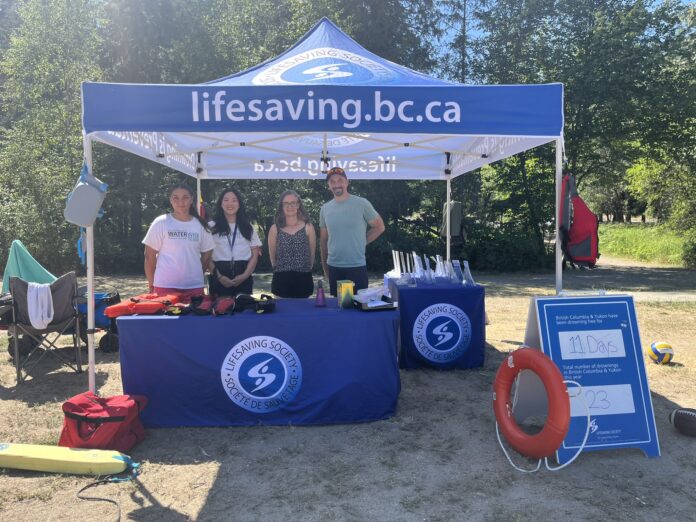It’s National Drowning Prevention Week, and the Lifesaving Society of BC is urging everyone to practise safe habits around water.
Amanda Beavers, Program Coordinator with the Lifesaving Society BC, said the event is held annually on the third week of July because that’s when most drowning-related injuries occur.
“When we actually get an opportunity to be in open water, we all want to rush out and go boating, go swimming, go cliff jumping, and July is when we see the highest frequency of that type of behaviour, which translates to many deaths or injuries.”
During National Drowning Prevention Week, the Lifesaving Society of BC campaigns across the province to educate people on drowning prevention.
On July 22 and 23, Beaver, along with members of the Lifesaving Society’s Water Wise Team, were at Christina Lake Provincial Beach educating people on important tips and strategies to remain safe near the water.
Beaver says drowning is preventable with simple strategies, such as always swimming with a life jacket and never swimming alone.
“Every year, about 400 Canadians go out to recreate around water and never return home, and that is preventable with simple strategies, such as never swimming alone so that someone can call for help, to wearing a life jacket.”
“Life jackets are the same concept as a seatbelt; you wouldn’t just bring your seatbelt with you in the car, you put it on so that it’s actually usable.”
She says most drowning-related injuries happen from an unexpected fall into the water, emphasizing the importance of wearing one while boating, fishing, or even while playing on a dock.
A recent report from the BC Coroners Service showed that the Southern Interior Region leads the province in the most accidental drowning deaths in the last decade.
Beavers believes this is likely because of the many freshwater lakes located in the region, which have strong undertows that people underestimate or don’t know how to navigate.
“A lot of times it’s in places that have currents, and individuals who don’t have a strong swimming ability or they’ve gone in to rescue somebody else that didn’t have a swimming ability. If you look in the interior, we have great lakes and rivers we want to recreate, but we don’t have the skill set or we’re not taking the precautions before we go.”
She says the statistics highlight the need for everyone in all age groups to ensure they recognize their skillsets as well as the variety of different factors that can impact safety in a natural body of water, such as currents, temperatures, and wind.
“When we’re choosing to recreate in the natural resources of our province, it’s important to know things like what to do if you fall into the water, how to help yourself, and how to get to safety.”
She recommends parents assign someone to watch children and youth consistently while they’re in or near the water and advises people to avoid swimming in areas that are known to have strong undertows.
“Before you ever go to a new environment make sure you’re asking locals, looking at signage, and ensure you’re going to choose a safe place. I would be avoiding any area that has any type of current and stay at those nice recreation beaches. Just because we see water and we know we can swim, it doesn’t mean we understand the risk of that actual environment.”
More information on drowning prevention and safe swimming practices can be found here.
Want to get your business noticed? Have you considered advertising through your local radio station? Speak to one of our sales agents and find out how radio advertising can boost your business today. Call 250-352-1902 or email Vista Radio.





